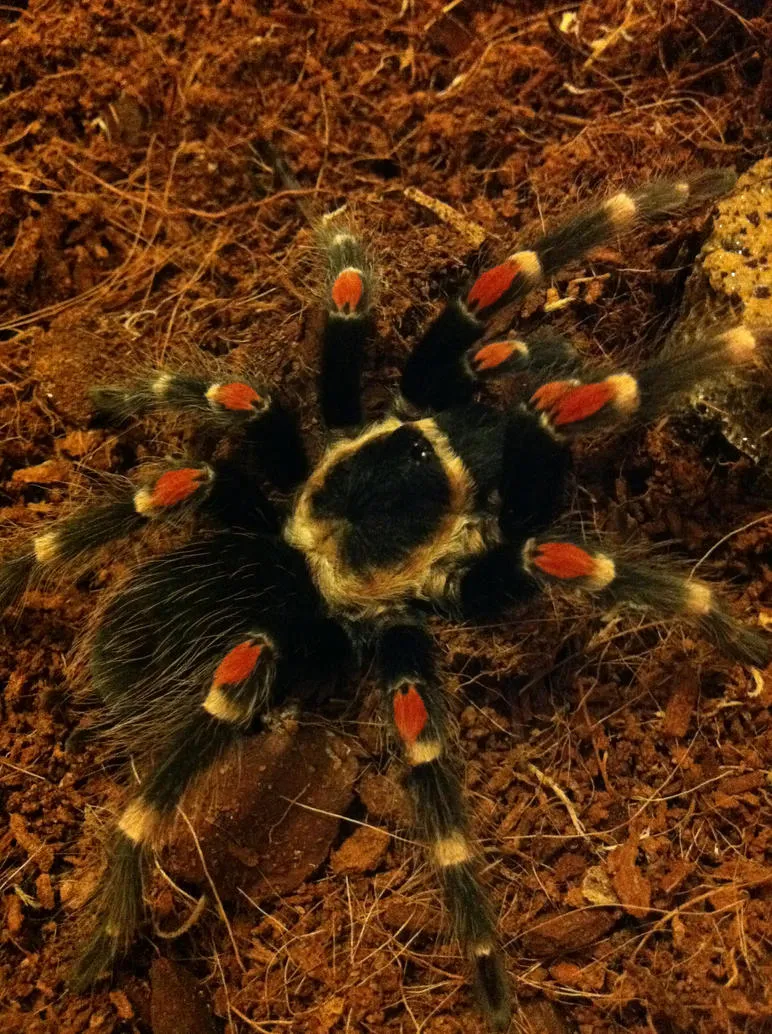What is a Mexican Flame Knee Tarantula (Overview)
The Mexican Flame Knee Tarantula (Brachypelma auratum) is a captivating and popular species among tarantula enthusiasts. Known for its striking coloration and relatively docile temperament, this tarantula hails from the Pacific coast of Mexico, specifically the states of Guerrero and Michoacán. Its vivid colors, featuring a black body with vibrant orange or red markings on its legs, make it a visually stunning pet. These arachnids have gained considerable attention in the pet trade, and many keepers enjoy the opportunity to observe their behaviors and provide the necessary care to ensure a healthy and thriving life. Their beauty and relatively calm demeanor have contributed to their popularity as pets, especially among beginners.
Appearance and Characteristics
The Mexican Flame Knee Tarantula is immediately recognizable due to its distinctive coloration. Adults typically display a velvety black carapace and abdomen, contrasted by vibrant orange or red bands on their leg joints, which give them their common name. The intensity of these colors can vary slightly depending on the individual tarantula, but the overall effect is striking. These tarantulas are medium-sized, with a leg span that can reach up to 5-6 inches. Females are generally larger and live longer than males. Their appearance is a key factor in their appeal, attracting both experienced keepers and newcomers to the hobby. Observing their beautiful appearance as they move around the enclosure is part of the fun of keeping them as pets.
Lifespan and Size
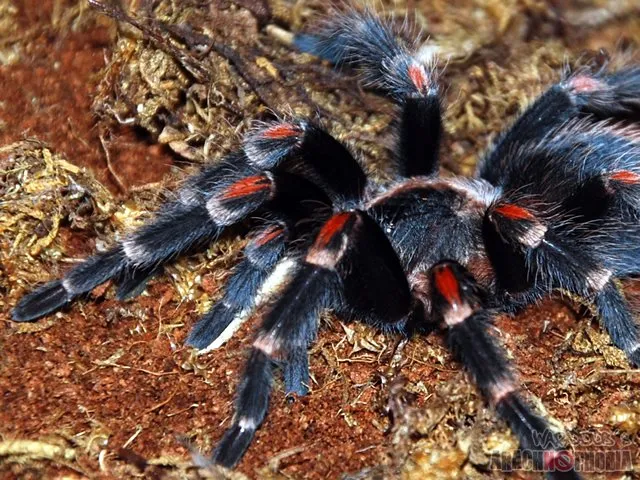
Female Mexican Flame Knee Tarantulas have a significantly longer lifespan than males. Females can live for 15 to 20 years, while males typically live only 5 to 7 years. The size of these tarantulas is another important aspect to consider. Fully grown females can achieve a leg span of around 5 to 6 inches, while males might be slightly smaller. The size and lifespan differences are crucial when planning for long-term care. The ability to properly house and care for them is essential for their comfort and well-being, from the smallest spiderlings through to the fully-grown adults. The keeper must consider these factors to ensure the tarantula thrives in its environment.
Mexican Flame Knee Tarantula Habitat Requirements
Creating the right habitat is crucial for the health and happiness of your Mexican Flame Knee Tarantula. This involves providing an appropriate enclosure, substrate, decor, and maintaining the correct temperature and humidity levels. Replicating their natural environment as closely as possible helps reduce stress and allows the tarantula to exhibit its natural behaviors. A well-designed habitat will not only keep your pet safe but also provide you with an engaging and enriching experience while observing it. Proper habitat design is an essential part of responsible tarantula ownership.
Enclosure Size and Setup
The size of the enclosure should be appropriate for the tarantula’s size. A juvenile Mexican Flame Knee Tarantula can be housed in a smaller enclosure, such as a 5-10 gallon tank. However, an adult tarantula requires a larger space, typically a 10-20 gallon tank or a similar-sized enclosure. The enclosure should have a secure lid to prevent escapes. Adequate ventilation is essential to prevent mold and maintain the proper humidity levels. It’s crucial to make sure the enclosure provides ample space to move around, and that the environment feels safe and secure.
Substrate and Decor
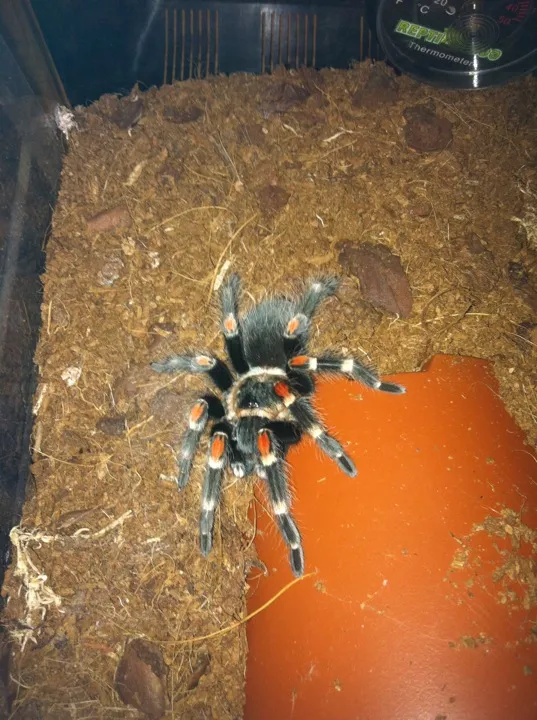
The substrate should be a few inches deep, allowing the tarantula to burrow if it chooses. Suitable substrate options include a mix of peat moss, coconut fiber, and vermiculite. This combination helps to retain moisture and allows for burrowing. Decorate the enclosure with hides such as cork bark, artificial plants, or other non-toxic items to provide hiding places and enrichment. Ensure the decor doesn’t pose any hazards, like sharp edges, that could harm your tarantula during molting or movement. Creating a naturalistic environment makes your pet feel secure and happy.
Temperature and Humidity
Maintaining the right temperature and humidity levels is critical for the well-being of your Mexican Flame Knee Tarantula. The ideal temperature range is between 75-85°F (24-29°C). Use a heat source, such as a heat mat placed on the side of the enclosure, to maintain the correct temperature. Avoid placing the heat mat directly under the enclosure, as this can cause the substrate to dry out too quickly. The humidity level should be kept between 60-70%. This can be achieved by misting the enclosure with water a few times a week. Use a hygrometer to monitor the humidity levels. Proper temperature and humidity will promote healthy molting and overall well-being.
Feeding Your Mexican Flame Knee Tarantula
Feeding your Mexican Flame Knee Tarantula is a relatively straightforward process. They are voracious eaters and readily accept a variety of insect prey. However, it’s important to offer a balanced diet and monitor their feeding habits to ensure they remain healthy. The correct feeding practices, along with proper hydration, will support the growth and overall health of the tarantula.
Diet and Feeding Frequency
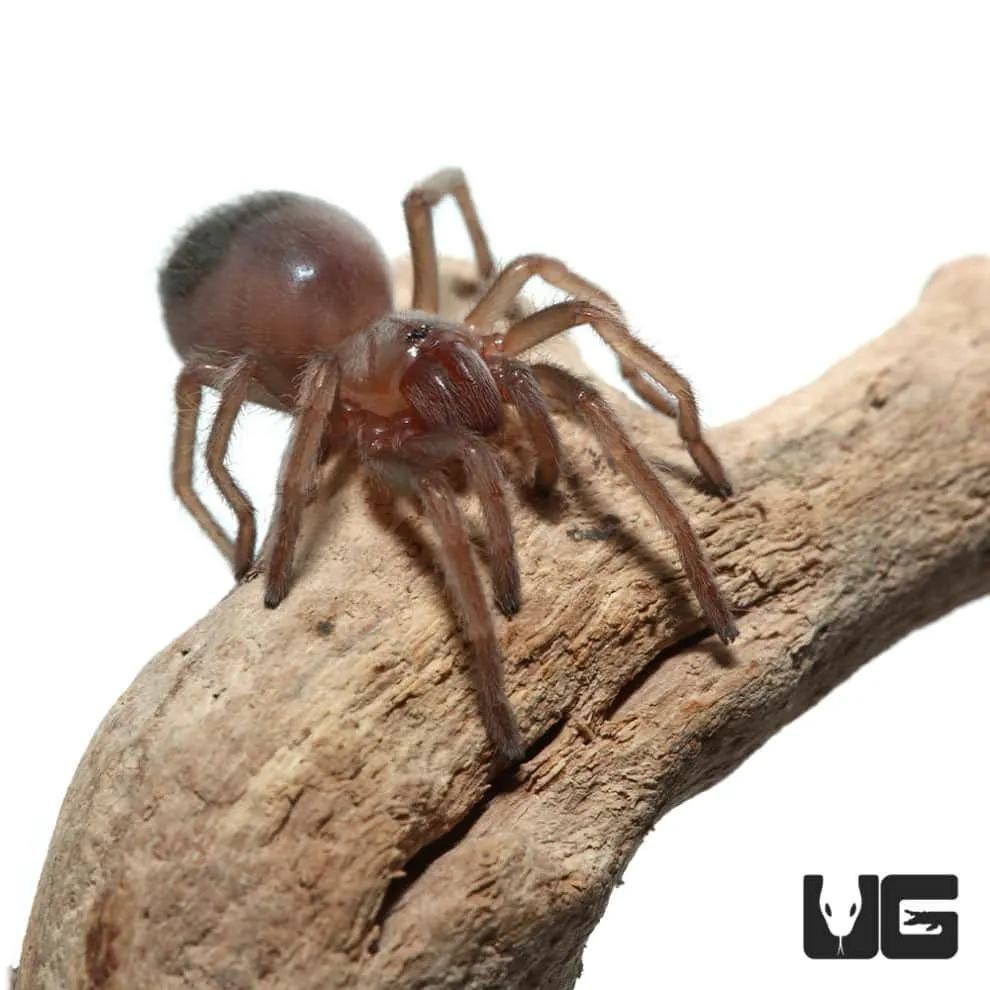
The primary diet of a Mexican Flame Knee Tarantula consists of live insects. Crickets, mealworms, and roaches are all suitable options. The size of the prey should be appropriate for the size of the tarantula; avoid feeding prey items larger than the tarantula’s body. Juveniles should be fed more frequently, perhaps 2-3 times a week, while adults can be fed once or twice a week. Remove uneaten prey within 24 hours to prevent stress or injury to your tarantula. Avoid overfeeding, as this can lead to obesity and other health issues.
Water and Hydration
Providing fresh water is essential for your tarantula’s hydration. Use a shallow water dish that the tarantula can easily access, and ensure it’s filled with clean water at all times. Alternatively, you can mist the enclosure regularly to provide droplets of water for the tarantula to drink. Always keep a watchful eye on the water source, cleaning and refilling the water dish as needed to maintain optimal hygiene. Hydration is vital for the tarantula’s health, especially during molting.
Handling and Safety Precautions
While the Mexican Flame Knee Tarantula is generally known for its docile nature, it’s important to approach handling with caution and respect for the animal. Always prioritize the safety of both yourself and the tarantula. Understanding their temperament and adhering to safety guidelines is key to preventing any unwanted incidents. Proper handling will allow you to appreciate your pet while minimizing any risk of stress or harm to either of you.
Tarantula Temperament
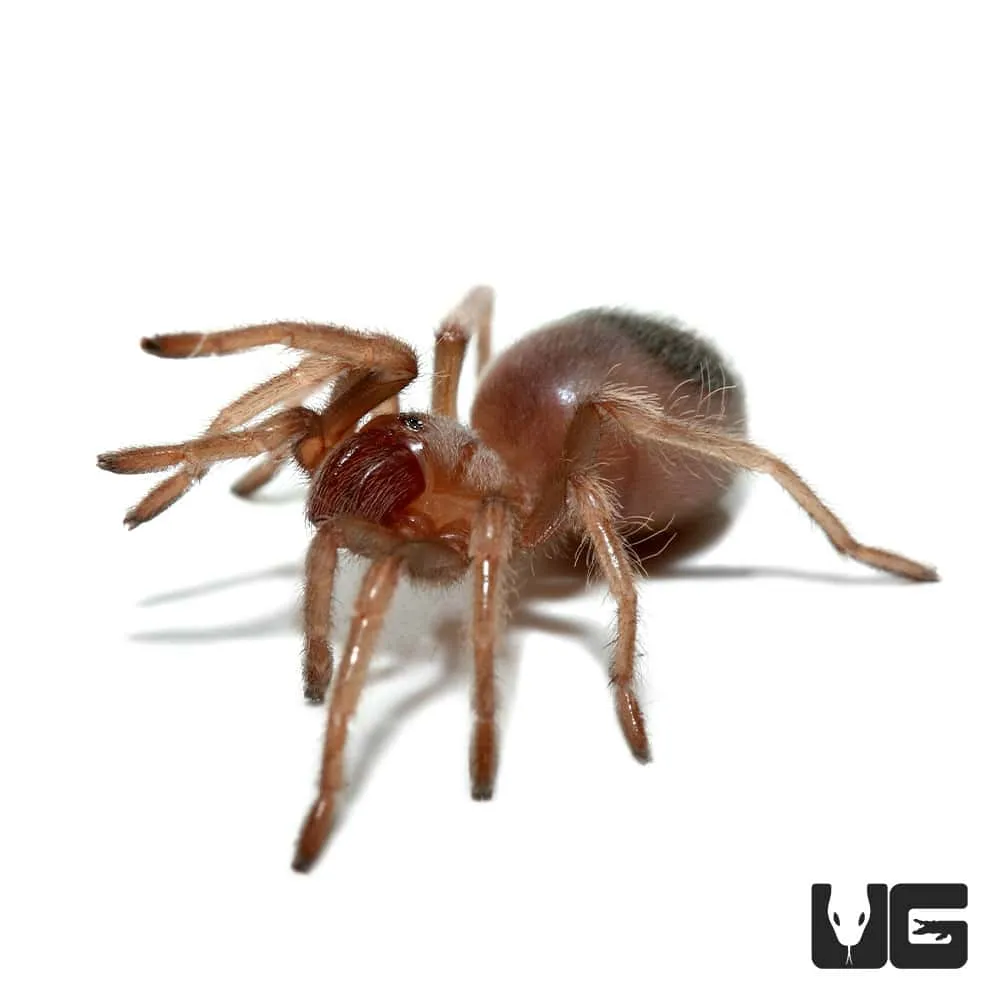
Mexican Flame Knee Tarantulas are typically not aggressive but can be skittish. They might flick urticating hairs from their abdomen as a defense mechanism, which can cause skin irritation. They may also try to escape if they feel threatened. It’s important to be aware of their potential behaviors and approach them calmly. Avoid sudden movements and respect their personal space. Knowing their temperament will help you handle them with confidence.
Handling Guidelines
Handling should be kept to a minimum, and only when necessary, such as for enclosure maintenance or health checks. If you must handle your tarantula, do so carefully and slowly. Encourage the tarantula to walk onto your hand, rather than trying to grab or force it. Handle them close to the ground to minimize the risk of injury if it falls. Always wash your hands thoroughly before and after handling to reduce the risk of spreading any contaminants. Avoid handling your tarantula if you have recently applied any lotions or creams on your hands, as they may contain chemicals that could harm your pet.
Common Health Issues and Care
Like all pets, Mexican Flame Knee Tarantulas can experience health issues. Recognizing potential problems early and providing appropriate care can help ensure a long and healthy life for your tarantula. Understanding the molting process and being able to identify and address common illnesses are essential aspects of responsible tarantula ownership.
Moulting Process
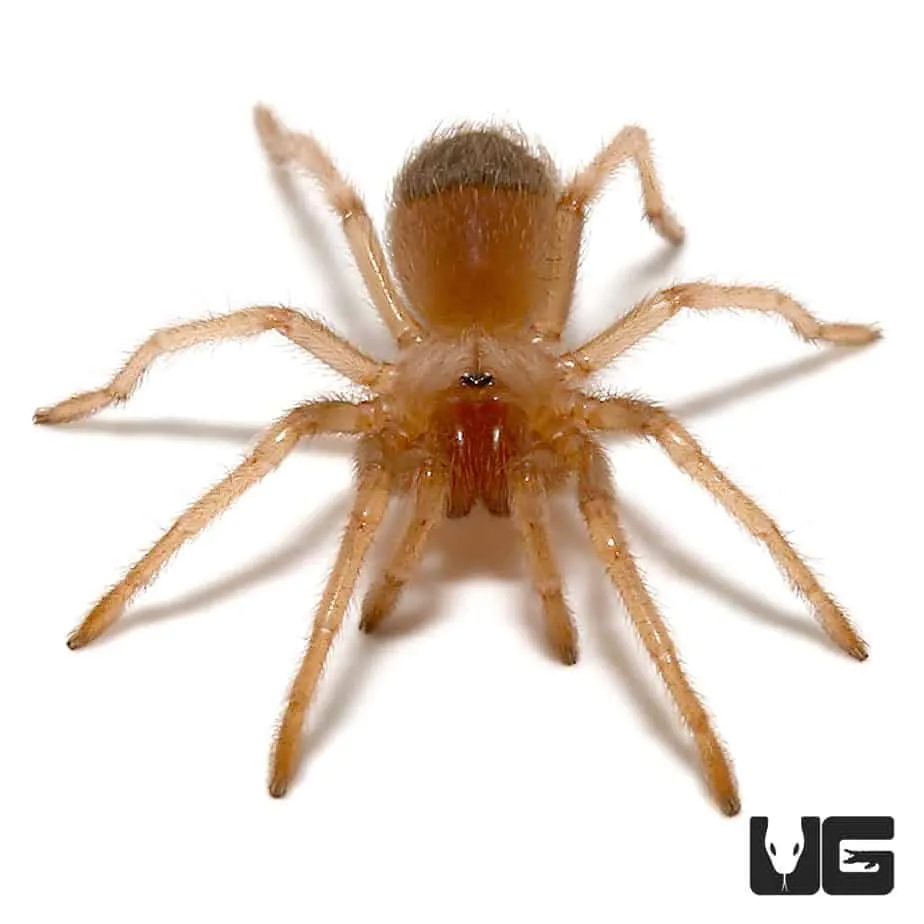
Moulting is the process where the tarantula sheds its exoskeleton to grow. During this period, the tarantula will typically stop eating, and you might observe it lying on its back. Provide a humid environment to help the tarantula during this process. Do not disturb the tarantula while it’s moulting. After moulting, the tarantula will be vulnerable, and it may take a few days for its fangs to harden before it can eat again. Proper preparation and understanding of the moulting process are vital for ensuring a healthy molt.
Identifying and Treating Illnesses
Monitor your tarantula for any signs of illness, such as lethargy, loss of appetite, or unusual behavior. Other indicators include changes in the abdomen’s appearance or signs of parasites. If you notice anything concerning, it’s important to consult with a veterinarian who specializes in exotic animals. Provide the right environmental conditions and follow the vet’s recommendations to give your tarantula the best chance of recovery. Early detection and intervention are key to successful treatment. Regularly inspecting your pet and its environment can help detect any emerging health issues.
Breeding
Breeding Mexican Flame Knee Tarantulas can be a rewarding experience for experienced keepers. It involves careful planning, understanding the mating process, and providing the appropriate conditions for raising spiderlings. While it may not be for everyone, it can provide insights into the life cycle and behaviors of these fascinating creatures.
Mating Process
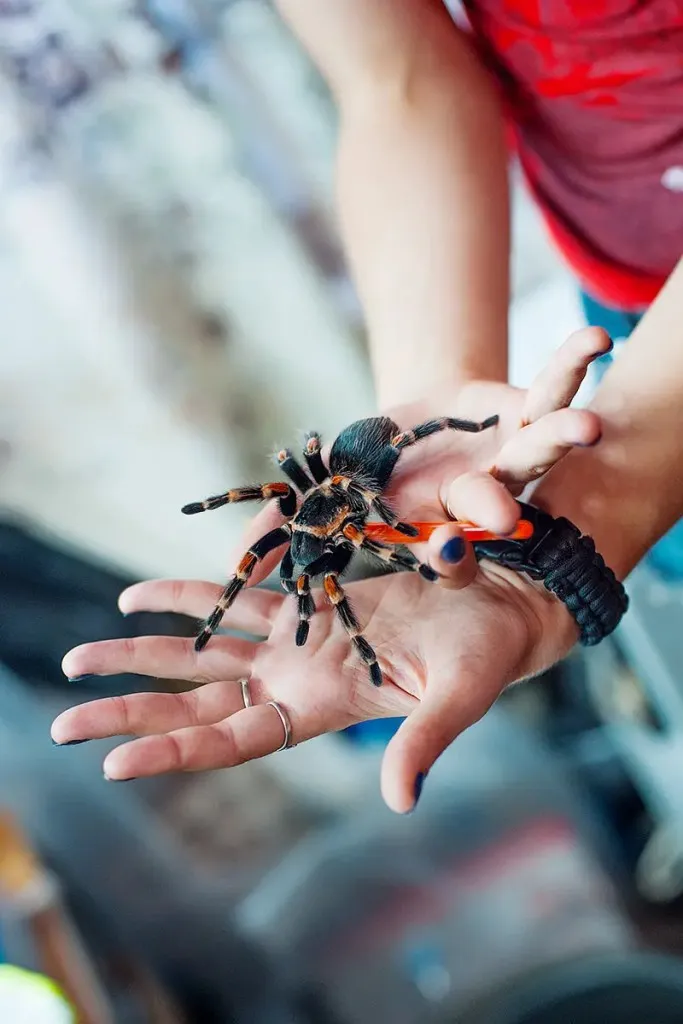
Breeding starts with introducing a mature male to a receptive female’s enclosure. The male will typically perform a mating dance, which involves tapping and drumming on the substrate. If the female is receptive, she will allow the male to mate with her. After mating, the female may become aggressive towards the male, so it’s important to remove him promptly to prevent injury. Careful monitoring of the female’s behavior and providing the proper environment for mating are crucial.
Raising Spiderlings
If the mating is successful, the female will produce an egg sac containing numerous spiderlings. Remove the egg sac from the female, or leave it for her to care for it. Once the spiderlings hatch, they will need to be separated and housed individually in small enclosures. Provide them with appropriate food, such as small fruit flies or pinhead crickets, and maintain the correct temperature and humidity. Raising spiderlings requires time and dedication, but the rewards are immeasurable.
Conclusion
Caring for a Mexican Flame Knee Tarantula can be a fulfilling experience. By understanding their habitat needs, diet, and health requirements, you can provide a safe and enriching environment for your pet. Remember to handle them with care and always prioritize their well-being. With proper knowledge and dedication, you can enjoy the beauty and fascinating behaviors of these beautiful tarantulas for many years to come. Enjoy the wonderful world of the Mexican Flame Knee Tarantula, and provide the best care possible!
